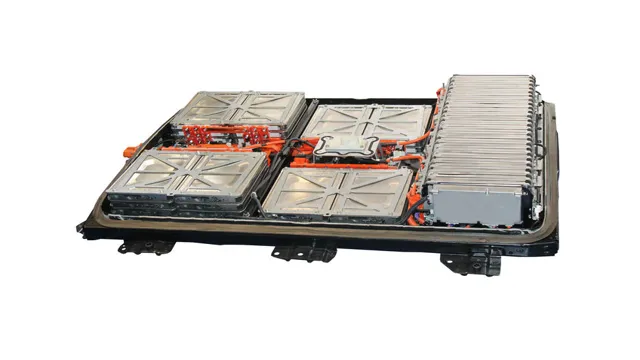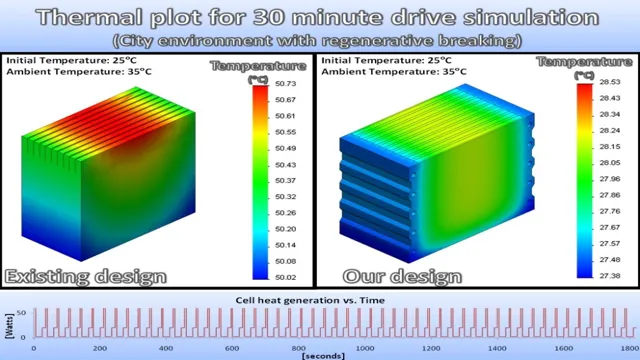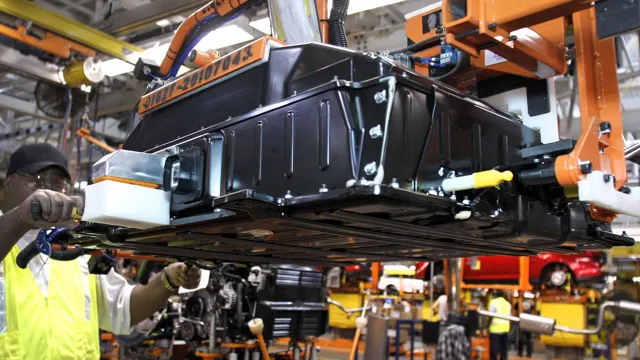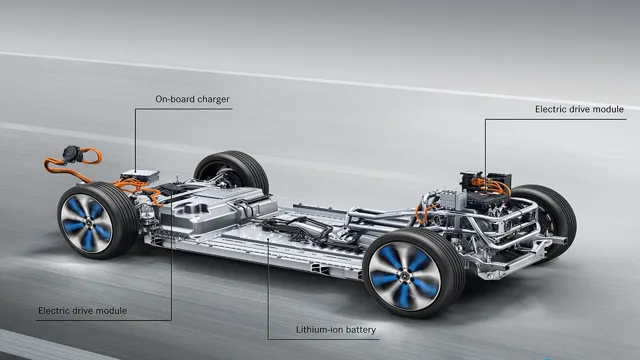Revving up Efficiency: The Importance of Electric Car Battery Thermal Management
Are you interested in purchasing an electric car but worried about how the battery will perform in hot or cold weather? The solution to this problem is electric car battery thermal management. This technology is essential to ensure the longevity of the battery and maintain its performance in various weather conditions. Simply put, thermal management is the process of regulating the temperature of the battery to prevent it from overheating or getting too cold.
A well-designed system can significantly improve the battery’s performance, increase its lifespan, and reduce the risk of damage or failure. Battery thermal management systems work by either actively heating or cooling the battery using air or liquid. These systems are often integrated with the car’s air conditioning or heating system and use sensors to monitor the temperature and adjust accordingly.
Without proper thermal management, the battery’s performance and lifespan can be severely impacted, leading to reduced range, slower charging times, and potentially expensive repairs. In this blog, we’ll delve deeper into the importance of electric car battery thermal management and how it works. We’ll also explore the different types of systems available and their pros and cons.
So if you’re curious about how to keep your electric car’s battery in top shape, keep reading!
Importance of Thermal Management
Electric car battery thermal management is an essential aspect of vehicle design and functionality. It refers to the process of regulating the temperature of the battery of an electric car to enhance its efficiency and lifespan. Proper thermal management can prevent overheating, which can lead to battery degradation and reduced performance.
On the other hand, inadequate thermal management can cause the battery to freeze, reducing its range and capacity. There are various thermal management methods, including liquid cooling and air cooling. Liquid cooling is more efficient and allows for more precise temperature regulation, but it’s also more costly than air cooling.
Electric car manufacturers must prioritize battery thermal management to ensure optimal performance and longevity of the battery.
Battery Performance and Lifespan
When it comes to maintaining the battery performance and lifespan of your electronic devices, thermal management plays a crucial role. Without effective heat dissipation, the temperature of your battery can rise quickly, leading to a decreased battery life and potential safety hazards. That’s why many devices, such as laptops and smartphones, come equipped with cooling systems like fans and heat sinks, to prevent overheating.
But it’s not just external factors that can impact battery temperature. Heavy usage, such as gaming or video playback, can also generate excess heat and put a strain on your device’s battery. So, it’s important to keep an eye on battery temperature and take steps to manage it, such as optimizing device settings or using cooling pads.
By doing so, you can ensure that your device’s battery performs at its best, lasts longer, and stays safe for use.

Safety Concerns
As technology advances, devices become smaller and more powerful, and the importance of thermal management in ensuring safety cannot be overstated. Proper thermal management is essential in preventing devices from overheating and causing damage or even injury. Overheating can also damage the components of a device, leading to failure and costly repairs.
To avoid these issues, thermal management systems are used to regulate the temperature of electronic devices and ensure that they operate within safe temperature ranges. These systems include heat sinks, fans, and thermal interface materials, which work together to dissipate heat and keep devices running smoothly. Without proper thermal management, electronic devices can pose a serious safety hazard, so it is crucial to prioritize this aspect in the design and production process.
How Thermal Management Works
Electric car battery thermal management is a crucial process that ensures the battery stays at the appropriate temperature to operate efficiently and extend its lifespan. Thermal management systems are designed to control the temperature of the battery pack by means of heating or cooling. In warmer climates, the battery may naturally heat up, causing damage or degradation to the battery cells.
On the other hand, in colder climates, the battery may not perform optimally due to low temperatures. Thermal management works by regulating the temperature of the battery pack to prevent overheating or overcooling, which can cause damage to the battery and drastically reduce its lifespan. Electric car manufacturers rely on these systems to ensure that their batteries maintain optimal performance and are safe for drivers to use on the road.
Active vs Passive
When it comes to thermal management, there are two main approaches: active and passive. Active thermal management utilizes mechanical or electrical components to control and adjust temperature, while passive thermal management relies on the design and materials of a system to regulate temperature. Active thermal management can include fans, pumps, or other devices to actively move air or liquid around a system and remove heat.
This approach is most often used in high-performance systems where a small amount of heat build-up can cause damage or affect performance. On the other hand, passive thermal management uses materials with high thermal conductivity and designs that maximize heat transfer to naturally dissipate heat. This approach is often used in more simple or lower power systems where the heat generated is not as significant.
Ultimately, the type of thermal management approach chosen depends on the specific requirements of the system and its intended use. Whether active or passive, thermal management plays an important role in ensuring the long-term performance and reliability of a system. At its most basic level, thermal management is all about keeping things cool – but it can also be an important factor in achieving optimal performance and efficiency.
Cooling and Heating Systems
Cooling and Heating Systems Have you ever wondered how thermal management works in cooling and heating systems? Well, it’s quite simple really. Thermal management involves transferring heat energy from one place to another, either to remove excess heat or provide warmth when needed. This process is achieved through the use of various mechanisms such as convection, conduction, and radiation.
Let’s take an air conditioning system, for instance. The air conditioning unit removes heat from the air inside your home and transfers it outside, keeping the indoor temperature cool and comfortable. Similarly, a heating system transfers heat from a fuel source to the air inside your home, warming it up during the colder months.
These systems utilize a range of techniques depending on the specific application, including heat pumps, refrigeration cycles, thermal storage, and more. Understanding how thermal management works in these systems can help you choose the most efficient and cost-effective options for your home.
Temperature Monitoring and Control
Temperature monitoring and control play a crucial role in maintaining the efficient functioning of electronic devices. Thermal management aims to keep the temperature of electronic components within safe limits by dissipating heat and preventing overheating. The process involves the use of sensors to monitor the temperature, and cooling systems such as fans, heat sinks, and liquid cooling to regulate it.
These cooling systems work by transferring heat from the electronic components to the surrounding environment, ensuring that the devices operate at optimal temperatures. In essence, thermal management is like the air conditioning system in a car; it ensures that the engine runs smoothly without overheating. An effective thermal management system is essential for prolonging the lifespan of electronic devices and preventing costly repairs, making it a vital aspect of any electronic design project.
Recent Advances in Technology
With the increasing demand for electric cars, the need for efficient and reliable battery thermal management systems has become a significant concern for manufacturers. Since electric car batteries tend to produce significant heat during operation, it is vital to manage this heat to optimize battery performance and durability. In recent years, technological advances have led to the development of advanced thermal management systems that keep the battery at an optimal temperature, ensuring maximum performance and longevity.
Some of the latest advancements in electric car battery thermal management include liquid cooling systems, active thermal management, and phase change materials. These technologies not only keep the battery at a stable temperature, but they also increase the range and efficiency of electric cars. With these advancements, electric car manufacturers can now produce cars that are competitive with gasoline-powered vehicles, a significant milestone for the electric car industry.
Moreover, it is now possible for consumers to use electric cars with peace of mind, knowing that advanced technology is managing their car’s battery to its best potential.
Liquid Cooling vs Air Cooling
In recent years, liquid cooling has become a popular alternative to traditional air cooling for high-performance computing systems. It uses liquid or water to dissipate heat from computer components, which is more efficient than air cooling. Recent advances in technology have made liquid cooling more practical, reliable, and affordable for both home and industrial use.
This technology makes use of a closed-loop system that circulates liquid coolant through channels or pipes that come into contact with the hot surfaces of the CPU, GPU, and other components. The coolant absorbs the heat and is then transported away from the components to a radiator, where it is cooled before being recirculated. Not only does this system provide better cooling performance, but it also reduces the noise and energy consumption of the system.
As technology continues to advance, liquid cooling is undoubtedly a reliable and efficient way to keep your computer running optimally.
Thermal Interface Materials
Thermal interface materials (TIMs) are essential components in modern electronic devices. They play a crucial role in dissipating heat from processors and other electronic components to prevent overheating and potential damage. Recently, there have been significant advancements in TIM technology, with new materials being developed that offer better thermal conductivity, improved durability and longevity, and reduced costs.
Graphene, for instance, has emerged as a promising material for TIMs due to its high thermal conductivity properties. Other materials such as thermally conductive adhesives, phase-change materials, and metallic pastes have also been developed to address the limitations of conventional TIMs. These new materials are also easier to apply, reducing the risk of inaccurate or uneven coverage.
With the growing demand for smaller, faster, and more powerful electronic devices, the continued evolution of TIM technology is essential to ensure reliable and efficient performance. So, what are your thoughts on the current advancements in TIM technology?
Future Impacts on Electric Cars
As electric cars become more popular, the importance of electric car battery thermal management cannot be overstated. The battery is the powerhouse of an electric car, and it needs to be kept at a specific temperature range to operate efficiently. If the battery gets too hot or too cold, it can impact the car’s performance and lifespan.
One approach to managing battery temperature is liquid cooling, which circulates a liquid coolant through the battery when it reaches high temperatures. Another approach is passive cooling, which uses heat-conducting materials to transfer heat away from the battery. Regardless of the approach, advancements in electric car battery thermal management will be crucial for the continued growth and success of the electric car industry.
Range and Charging Time Improvements
Electric Cars The advancement of technology has led to significant improvements in electric cars regarding range and charging time. Longer ranges are now possible thanks to high-capacity batteries that can store more energy, while faster charging times are possible with more powerful charging stations and advanced charging protocols. These improvements are set to impact the future of electric cars by making them more convenient and practical for everyday use.
A longer range means that drivers can travel further without needing to stop and charge, which makes it easier to plan long trips. Faster charging times mean that drivers can spend less time waiting for their car to charge, making it more convenient to use electric cars for daily commutes. As battery and charging technology continues to improve, we can expect even more significant improvements in the future, making electric cars an increasingly attractive alternative to traditional gasoline-powered vehicles.
Increased Demand for Electric Cars
With the increasing demand for electric cars, there are a lot of potential impacts that can shape the future of the automotive industry. From environmental benefits to financial incentives, electric vehicles are becoming more attractive to consumers worldwide. As more manufacturers invest in EV technology, we can expect to see a rapid increase in the number of electric cars on the roads in the coming years.
This, in turn, will contribute to the expansion of charging stations and the development of new battery technologies. Moreover, with the rise of 5G networks and the Internet of Things (IoT), manufacturers can leverage these technologies to introduce sophisticated features that enhance the user experience. For example, smart charging that optimizes the time and speed of charging will be critical to improving the convenience of EVs.
In conclusion, the future of electric cars looks bright, and we can expect significant impacts on our roads, economy, and environment in the coming years.
Conclusion
In the world of electric cars, battery thermal management isn’t just a technical term, it’s a potential game-changer. Without proper management, those smooth rides with no tailpipe emissions can quickly turn into hot (and expensive) disasters. But with this technology in place, drivers can enjoy all the perks of electrification without worrying about their battery’s well-being.
So, the next time someone tells you that electric cars lack the “heat” of their gas-guzzling counterparts, just remind them that sometimes, it’s better to stay cool.”
FAQs
What is electric car battery thermal management?
Electric car battery thermal management is a system that controls the temperature of the battery pack in an electric vehicle.
Why is thermal management important for electric car battery?
Thermal management is important for electric car batteries as it helps to maintain optimal temperature range that ensures the battery’s longevity and performance.
How does electric car battery thermal management work?
Electric car battery thermal management works by regulating the temperature of the battery pack through various cooling and heating mechanisms.
What are some common thermal management techniques used in electric car batteries?
Some common thermal management techniques used in electric car batteries are liquid cooling, air cooling, and phase-change material-based cooling. These techniques keep the battery pack’s temperature in the safe operating range.
Can improper thermal management affect the performance of an electric car battery?
Yes, improper thermal management can affect the performance of an electric car battery negatively, leading to reduced range and longevity of the battery pack.





